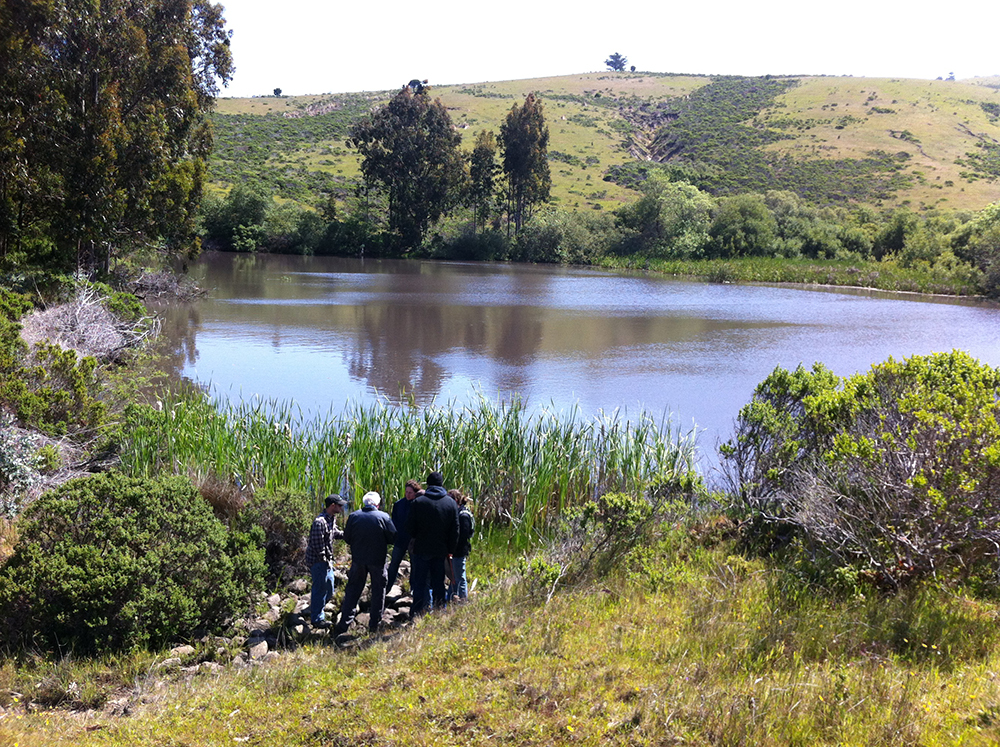100 Ponds Project
Water availability is and will be one of the most significant forces shaping the future of agriculture and the environment in California. In San Mateo County, we have the opportunity to offer solutions and leadership for both needs through careful planning and water supply management.
The 100 Ponds Project is an ambitious initiative to construct, repair, enhance and restore farm ponds and other water retention features for an array of environmental, agricultural, and economic benefits. The 100 Ponds Project is an essential component of an overall agricultural water stewardship program at the RCD that provides integrated benefits for drought preparedness, climate change resilience, ecosystem restoration and protection, and public health. Hardly a new technology, good old fashioned farm ponds are widely viewed as a primary and essential tool for balancing competing demands on limited water resources in coastal San Mateo and beyond.
On-farm ponds and similar water retention features (cisterns, seasonal wetlands, etcetera) can capture and store rainwater for use later in the season, store runoff or tailwater from irrigation events for reuse on the farm, bring water to far reaches of a ranch to enable better management of cattle on the landscape for beneficial resource management, and enable farmers to divert and store water during high flow winter months so that they do not take water from the creeks during low flow summer months. Most of the agricultural operations in the County that irrigate depend on water from creeks and streams during the summer months.
These same creeks are home to threatened and endangered species such as coho salmon and steelhead trout. Many of these coastal streams do not have adequate water, particularly in drought years. To maintain agricultural viability, stream habitats, and our local fishery, alternatives to summer diversions must be developed. Off-stream storage ponds are constructed away from streams and filled with winter rainfall, recycled irrigation water, and/ or water diverted from streams during high flow winter storms. The stored water is then used by farmers and ranchers during the summer dry season when water supply can be critically low, providing more water in the stream for fish and aquatic wildlife.
Capturing water in many places can not only add meaningful regional capacity when considered in aggregate, but can have significant localized impact. Individually and collectively, water retention features on the landscape in San Mateo County will achieve a stunning array of benefits:
- Drought and climate change resilience for agriculture, aquatic species, and domestic water supply
- Reducing downstream flooding by capturing peak winter flows
- Offsetting withdrawals in dry summer months to protect instream flows for endangered coho salmon and threatened steelhead trout
- Providing water in far reaches of ranches so that cattle ranchers can implement best management practices for improved soil health, native vegetation communities, carbon sequestration, soil water retention, drought resilience, and more.
- Creating wildlife habitat for the threatened and endangered species such as the California red-legged frog and San Francisco garter snake, as well as migratory birds and other wildlife
- Enabling reduced pumping, resulting in lower energy use and costs
- Recharging local groundwater for improved groundwater supply and water lasting in creeks later into the dry season
- Benefitting local farms, food security, and the local rural economy
The California Climate and Agriculture Network regularly advocates for farm/ ranch ponds as means both to mitigate for and build resilience to climate change. The 100 Ponds Project was recently identified as a top priority for the San Mateo Food System Alliance to address cross-cutting issues pertaining to the foodshed in San Mateo County. Off-stream storage ponds reducing summer diversions have been identified as high priorities in local watershed plans as well as the state and federal recovery plans for coho salmon and steelhead trout. The need has been identified in the 2003 San Mateo County Agriculture Summit, and the 2012 and 2014 Ag Workshops hosted by San Mateo County Supervisor Don Horsley.
The ponds will be located on the San Mateo County coast where we see the greatest nexus of agriculture and critical habitat for the species to benefit. Lessons learned, including permitting terms and strategy, will be transferable and broadly and openly shared.
Partners:
- Trout Unlimited
- American Rivers
- landowners, farmers, and ranchers
- San Mateo Food System Alliance
- USDA Natural Resources Conservation Service.
RCD Contact: Joe Issel
Completed projects include the Repetto Farms Pond Project, the Harley Farms Reservoir, the Blue House Farm Pond, Carpy Ranch Pond, and Butano Farms Pond.

